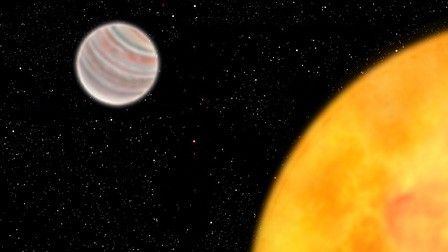1 min read
Artist’s View of Exoplanet Orbiting the Star HD 189733

This is an artist's impression of the Jupiter-size extrasolar planet, HD 189733b, being eclipsed by its parent star. Astronomers using the Hubble Space Telescope have measured carbon dioxide and carbon monoxide in the planet's atmosphere. The planet is a "hot Jupiter," which is so close to its star that it completes an orbit in only 2.2 days.
This type of observation is best done when the planet's orbit carries it behind the star (as seen from Earth), which allows an opportunity to subtract the light of the star alone (when the planet is blocked) from that of the star and planet together prior to eclipse. This allows astronomers to isolate the infrared emission of the planet and make spectroscopic observations that chemically analyze the day-side atmosphere.
The planet is too hot for life as we know it. But under the right conditions, on a more Earth-like world, carbon dioxide can indicate the presence of extraterrestrial life. This observation demonstrates that chemical biotracers can be detected by space telescope observations.
About the Object
- R.A. PositionR.A. PositionRight ascension – analogous to longitude – is one component of an object's position.20h 00m 43s.71
- Dec. PositionDec. PositionDeclination – analogous to latitude – is one component of an object's position.+22° 42' 39".07
- ConstellationConstellationOne of 88 recognized regions of the celestial sphere in which the object appears.Vulpecula
- DistanceDistanceThe physical distance from Earth to the astronomical object. Distances within our solar system are usually measured in Astronomical Units (AU). Distances between stars are usually measured in light-years. Interstellar distances can also be measured in parsecs.63 light-years (19 parsecs)
About the Data
- Data DescriptionData DescriptionProposal: A description of the observations, their scientific justification, and the links to the data available in the science archive.
Science Team: The astronomers who planned the observations and analyzed the data. "PI" refers to the Principal Investigator.This science result was from HST data from proposal 10855: M. Swain (NASA's Jet Propulsion Laboratory) and D. Deming (NASA Goddard Space Flight Center). The science team includes: M. Swain, G. Vasisht , and P. Chen (NASA's Jet Propulsion Laboratory), G. Tinetti (University College London), J. Bouwman (Max-Planck Institute for Astronomy, Heidelberg), Y. Yung (California Institute of Technology), and D. Deming (NASA Goddard Space Flight Center). - InstrumentInstrumentThe science instrument used to produce the data.HST>NICMOS
- Exposure DatesExposure DatesThe date(s) that the telescope made its observations and the total exposure time.April 29/30, 2007, Exposure Time: 324 seconds
- FiltersFiltersThe camera filters that were used in the science observations.G206 (1.4-2.5 microns)
- Object NameObject NameA name or catalog number that astronomers use to identify an astronomical object.HD 189733b
- Object DescriptionObject DescriptionThe type of astronomical object.Transiting Hot-Jupiter Exoplanet
- Release DateDecember 9, 2008
- Science ReleaseHubble Finds Carbon Dioxide on an Extrasolar Planet
- Credit
Related Images & Videos

Illustration of Exoplanet Orbiting the Star HD 189733
This illustration shows the Jupiter-sized planet HD 189733b and its parent star. Hubble takes a spectrum of the star HD 189733 and the fully illuminated planet. By subtracting the star's spectrum from the combined spectrum, the spectrum of the planet is obtained. Astronomers now...

Carbon Dioxide Found on Planet Outside of Our Solar System
The Hubble Space Telescope detects the presence of carbon dioxide on a planet 63 light-years away. This discovery is the latest in a series of observations confirming the existence of chemical biotracers on planets outside of our solar system. Researchers involved with the...
Share
Details
Claire Andreoli
NASA’s Goddard Space Flight Center
Greenbelt, Maryland
claire.andreoli@nasa.gov





























